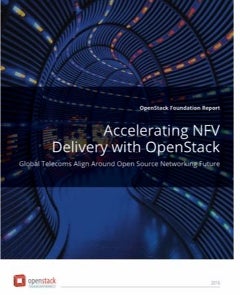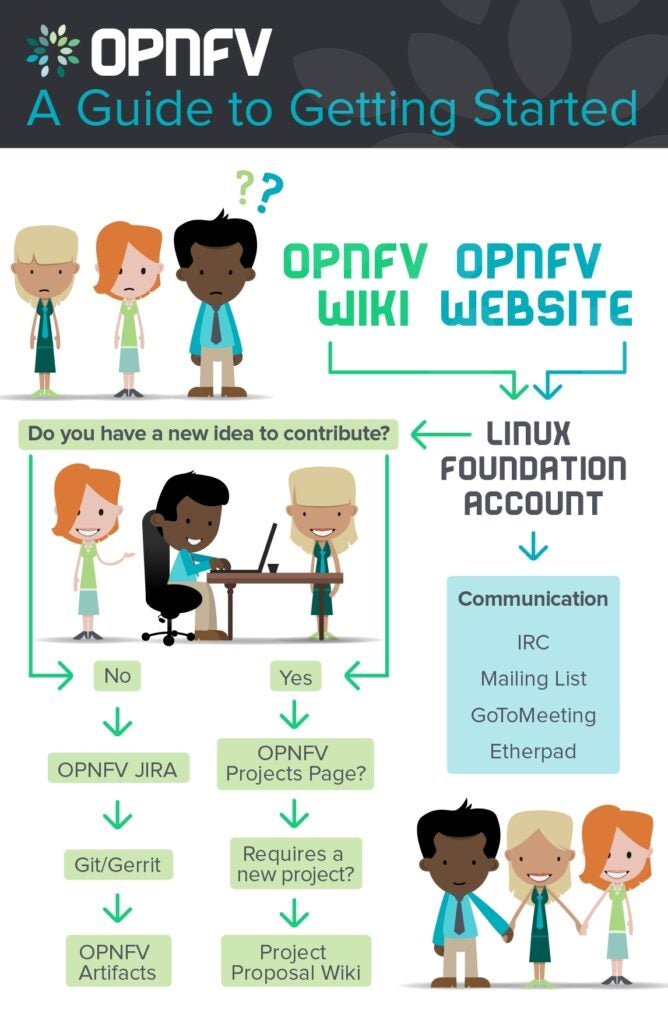OPNFV member roster expands as research institutes and software vendors commit to help advance state-of-the-art open source NFV platform
SAN FRANCISCO, January 19, 2016 — The OPNFV Project, a carrier-grade, integrated, open source flexible platform intended to accelerate the introduction of new products and services using Network Functions Virtualization (NFV), today announced that Openet, a supplier of real-time BSS (business support systems) to communication service providers, has joined as a Silver member while the Electronics and Telecommunications Research Institute (ETRI) and the University of New Hampshire InterOperability Laboratory (UNH-IOL) have joined as Associate members. Launched just over a year ago, the OPNFV project is supported by a growing group of 55+ member companies committed to advancing a flexible, open source framework for NFV.
“I’m thrilled to kick off the new year by welcoming three new organizations to OPNFV,” said Heather Kirksey, director, OPNFV. “Openet brings a wealth of telecom software development experience to the community, and with research institutions ETRI and UNH-IOL with their expertise in testing and Compliance & Certification also joining, I’m eager to see where this range of perspectives takes the project in 2016.”
ETRI, a non-profit government-funded research institute, has been at the forefront of technological excellence since 1976. Contributions include the development of TDX (Time Division Exchange) and 4M DRAM (Dynamic Random Access Memory); the commercialization of CDMA (Code Division Multiple Access) and the Terrestrial DMB, WiBro, and 4G LTE Advanced, which became the foundation of mobile communications. Most recently, as a global ICT leader, ETRI has been advancing communication and convergence by developing SAN (Ship Area Network) technology, Genie Talk (world class portable automatic interpretation; Korean-English/Japanese/Chinese), and automated valet parking technology.
“The future of network technology depends on implementations of the NFV platform that go beyond the Physical Network Function,” said Sun Hee Yang, senior director, ETRI. “Joining OPNFV will enable greater access to open collaboration with other researchers and developers across the globe who are working to shape the future of networking. We’re excited to become a part of the community and contribute our expertise and resources to building a strong open NFV platform.”
Openet is the leading independent supplier of real-time BSS (business support systems) to communication service providers. Openet software ensures that more than 600 million mobile telecoms users around the world enjoy the best network and data experience while enabling operators to monetize data use in ‘real-time’. Since its foundation in 1999, Openet has constantly been at the forefront of telecoms software development and innovation. This is characterized by its open platform, domain experience and engineering expertise. Its success is personified by the many long-term relationships it has fostered with the largest, most progressive, and demanding operators across the globe.
Joe Hogan, Openet CTO stated: “Openet has long supported solutions that are virtualized, vendor- agnostic and built using open standards. We are delighted to be part of OPNFV and look forward to contributing to the OPNFV carrier-grade platform to help enable operators deliver a faster time-to-market for new services and new revenue streams.”
The UNH-IOL is a well-known independent, third-party laboratory dedicated to broad-based testing and standards conformance services for networking industries. Since 1988, the lab has fostered multi-vendor interoperability while preparing students for careers in the industry. The UNH-IOL has grown steadily into one of the industry’s premier independent testing labs for new technologies and a hub for developing custom test solutions.
“We’re proud to be joining the existing community of experts working together toward the common goal of accelerating open source NFV,” said Erica Johnson, director, UNH-IOL. “We’re looking forward to leveraging our Associate membership in OPNFV to exchange research, resources and testing with like-minded community members and help shape the future of networking.”
With more than 100 developers from both service providers and commercial suppliers collaborating on the development of an open source, carrier-grade, integrated platform for NFV, the community is hard at work on its second release, Brahmaputra, due next month. Brahmaputra will bring additional projects and features to the platform as well as additional documentation. An early look at what’s coming in Brahmaputra is available here, and details on the first OPNFV release, Arno, are available here.
About the Open Platform for NFV (OPNFV)
Open Platform for NFV is a carrier-grade, integrated, open source flexible platform intended to accelerate the introduction of new products and services using NFV. It brings together service providers, vendors and users to collaborate in an open forum on advancing the state-of-the-art in NFV. For more information, please visit http://www.opnfv.org.
OPNFV is Collaborative Project at the Linux Foundation. Linux Foundation Collaborative Projects are independently funded software projects that harness the power of collaborative development to fuel innovation across industries and ecosystems. www.linuxfoundation.org.
Additional Resources
How to Participate
OPNFV Resources
OPNFV Blog
OPNFV Events
Media Inquires
Jill Lovato
OPNFV Project
pr@opnfv.org
 NFV is picking up steam as more telecom and enterprise network operators recognize the scalability and flexibility of controlling their network functions via open source software and commercial off-the-shelf hardware. Operators are realizing that achieving rapid time-to-market for NFV systems requires a carrier-grade, end-to-end testing and integration platform such as OPNFV.
NFV is picking up steam as more telecom and enterprise network operators recognize the scalability and flexibility of controlling their network functions via open source software and commercial off-the-shelf hardware. Operators are realizing that achieving rapid time-to-market for NFV systems requires a carrier-grade, end-to-end testing and integration platform such as OPNFV.
 About Maryam Tahhan
About Maryam Tahhan The OPNFV community is hard at work on our second release, Brahmaputra, planned for February 2016. We’ve just hit Milestone D, which means the release is API and feature-complete! As we work to finalize the release, we wanted to provide a quick sneak peek into what’s ahead.
The OPNFV community is hard at work on our second release, Brahmaputra, planned for February 2016. We’ve just hit Milestone D, which means the release is API and feature-complete! As we work to finalize the release, we wanted to provide a quick sneak peek into what’s ahead. Chris Price
Chris Price Heather Kirksey
Heather Kirksey Having just hit the one-year mark, we wanted to get a sense of how we’re doing from perspective of the telecom industry. So we commissioned
Having just hit the one-year mark, we wanted to get a sense of how we’re doing from perspective of the telecom industry. So we commissioned  OPNFV consists of multiple projects focusing on everything from hardware management to KVM enhancements to running applications. We work closely with underlying upstream projects to help accelerate NFV via an integrated, open platform. Beyond new features, our main focus is integrating of open source components into the platform with proper verification and validation. We have several projects designed to to drive upstream implementation and provide hardware infrastructure, tool sets, testing frameworks and so forth. Furthermore, we encourage every participating member to use Agile methodologies as we believe in speed, proactivity and flexibility. If you would like to learn more about OPNFV in general before jumping in, feel free to reference the
OPNFV consists of multiple projects focusing on everything from hardware management to KVM enhancements to running applications. We work closely with underlying upstream projects to help accelerate NFV via an integrated, open platform. Beyond new features, our main focus is integrating of open source components into the platform with proper verification and validation. We have several projects designed to to drive upstream implementation and provide hardware infrastructure, tool sets, testing frameworks and so forth. Furthermore, we encourage every participating member to use Agile methodologies as we believe in speed, proactivity and flexibility. If you would like to learn more about OPNFV in general before jumping in, feel free to reference the  Ildikó Váncsa
Ildikó Váncsa Peter Lee leads R&D at
Peter Lee leads R&D at